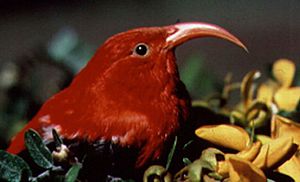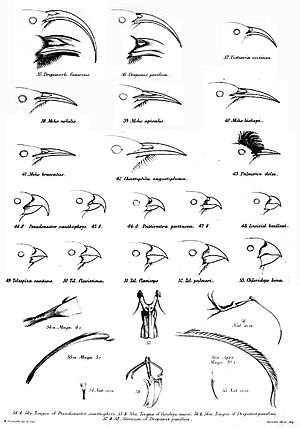Hawaiian honeycreeper facts for kids
Quick facts for kids Hawaiian honeycreeper |
|
|---|---|
 |
|
| ʻIʻiwi (Drepanis coccinea) | |
| Scientific classification |
|
| Kingdom: | Animalia |
| Phylum: | Chordata |
| Class: | Aves |
| Order: | Passeriformes |
| Family: | Fringillidae |
| Subfamily: | Carduelinae |
| Genera | |
|
See text |
|
| Synonyms | |
|
Drepanididae |
|

Hawaiian honeycreepers are amazing small birds that live only in Hawaiʻi. This means they are endemic to Hawaiʻi, found nowhere else in the world! They are known for their incredible variety of beak shapes and sizes, which helped them eat different foods. These birds are related to rosefinches and are a great example of how animals can change and adapt over time to fit different environments.
For a long time, scientists weren't sure how Hawaiian honeycreepers were related to other birds. They used to group them in different ways, sometimes as their own bird family called Drepanididae. Other times, they were seen as a smaller group, or subfamily, within the finch family. Thanks to new ways of studying their DNA, scientists now know that Hawaiian honeycreepers are part of the finch family, specifically within a group called Carduelinae.
Amazing Bird Features
Nearly all Hawaiian honeycreepers have a special smell to their feathers. Many researchers have described it as smelling "rather like old canvas tents."
These birds have a wide range of bill shapes. Some have thick, strong beaks like finches, perfect for cracking seeds. Others have long, thin, curved beaks, great for reaching nectar deep inside flowers. This amazing variety of beaks happened because the birds adapted to fill many different ecological niches, or roles, in their environment. For example, many honeycreepers love to drink nectar from the native ʻōhiʻa (Metrosideros polymorpha) flowers.
Sadly, many Hawaiian honeycreeper species have disappeared. About 20 species have become extinct in recent times. Many more disappeared even earlier, after humans arrived in Hawaiʻi. Humans brought new animals like rats, pigs, goats, and cows, which harmed the birds' habitats. They also changed the land for farming.
Types of Hawaiian Honeycreepers
This section lists some of the different kinds of Hawaiian honeycreepers. "Prehistoric" means species that became extinct after humans first settled in Hawaiʻi (around the late 1st millennium AD) but before Europeans arrived in 1778.
Subfamily Carduelinae
- Drepanidini
- Genus Aidemedia – These birds had straight, thin bills and ate insects.
- Aidemedia chascax – Oʻahu icterid-like gaper (prehistoric)
- Aidemedia lutetiae – Maui Nui icterid-like gaper (prehistoric)
- Aidemedia zanclops – sickle-billed gaper (prehistoric)
- Genus Akialoa – These had pointed, long, and curved bills. They ate insects or nectar.
- Akialoa ellisiana – Oʻahu ʻakialoa (extinct, 1940)
- Akialoa lanaiensis – Maui Nui ʻakialoa (extinct, 1892)
- Akialoa stejnegeri – Kauaʻi ʻakialoa (extinct, 1969)
- Akialoa obscura – lesser ʻakialoa (extinct, 1940)
- Akialoa upupirostris – hoopoe-billed ʻakialoa (prehistoric)
- Genus Chloridops – These had thick bills, perfect for cracking hard seeds.
- Chloridops kona – Kona grosbeak (extinct, 1894)
- Chloridops regiskongi – King Kong grosbeak (prehistoric)
- Chloridops wahi – wahi grosbeak (prehistoric)
- Genus Chlorodrepanis – These had pointed bills and ate both insects and nectar.
- Chlorodrepanis stejnegeri – Kauaʻi ʻamakihi
- Chlorodrepanis flava – Oʻahu ʻamakihi
- Chlorodrepanis virens – Hawaiʻi ʻamakihi
- Genus Ciridops – These were finch-like and ate fruit from Pritchardia trees.
- Ciridops anna – ʻula-ʻai-hāwane (extinct, 1892 or 1937)
- Ciridops tenax stout-legged finch (prehistoric)
- Genus Drepanis – These had curved bills and drank nectar.
- Drepanis funerea – black mamo (extinct, 1907)
- Drepanis pacifica – Hawaiʻi mamo (extinct, 1898)
- Drepanis coccinea – ʻiʻiwi
- Genus Dysmorodrepanis – This bird had a pincer-like bill, possibly for eating snails.
- Dysmorodrepanis munroi – Lanaʻi hookbill (extinct, 1918)
- Genus Hemignathus – These had pointed or long, curved bills and ate insects.
- Hemignathus affinis – Maui nukupuʻu (extinct, 1995–1998)
- Hemignathus hanapepe – Kauaʻi nukupuʻu (extinct, 1998)
- Hemignathus lucidus – Oʻahu nukupuʻu (extinct, 1837)
- Hemignathus vorpalis – giant nukupu'u (prehistoric)
- Hemignathus wilsoni – ʻakiapolaʻau
- Genus Himatione – These had thin bills and drank nectar.
- Himatione sanguinea – ʻapapane
- Himatione fraithii – Laysan honeycreeper (extinct, 1923)
- Genus Loxioides – These were finch-like and specialized in eating seeds from Fabales plants.
- Loxioides bailleui – palila
- Loxioides kikuichi – Kaua'i palila (prehistoric, possibly survived to the early 18th century)
- Genus Loxops – These had small, pointed bills with slightly crossed tips, and ate insects.
- Loxops caeruleirostris – ‘akeke‘e
- Loxops coccineus – Hawaiʻi ʻakepa
- Loxops ochraceus – Maui ʻakepa (extinct, 1988)
- Loxops wolstenholmei – Oʻahu ʻakepa (extinct, 1990s)
- Loxops mana – Hawaiʻi creeper
- Genus Magumma – These had small, pointed bills and ate insects and nectar.
- Magumma parva – ʻanianiau
- Genus Melamprosops – This bird had a short, pointed bill and specialized in eating insects and snails.
- Melamprosops phaeosoma – poʻouli (possibly extinct, November 28, 2004?)
- Genus Oreomystis – These had short, pointed bills and ate insects.
- Oreomystis bairdi – ʻakikiki
- Genus Orthiospiza – This bird had a large, weak bill, possibly for eating soft seeds or fruit.
- Orthiospiza howarthi – highland finch (prehistoric)
- Genus Palmeria – These had thin bills, drank nectar, and especially liked Metrosideros polymorpha flowers.
- Palmeria dolei – ʻakohekohe
- Genus Paroreomyza – These had short, pointed bills and ate insects.
- Paroreomyza maculata – Oʻahu ʻalauahio (possibly extinct, early 1990s?)
- Paroreomyza flammea – kākāwahie (extinct, 1963)
- Paroreomyza montana
- Paroreomyza montana montana – Lana'i 'alauahio (extinct, 1937)
- Paroreomyza montana newtoni – Maui ‘alauahio
- Genus Pseudonestor – This bird had a parrot-like bill, used for digging into wood to find insect larvae.
- Pseudonestor xanthophrys – Maui parrotbill or kiwikiu
- Genus Psittirostra – This bird had a slightly hooked bill and specialized in eating Freycinetia arborea fruit.
- Psittirostra psittacea – ʻōʻū (probably extinct, 1998?)
- Genus Rhodacanthis – These had large bills and specialized in eating legume seeds.
- Rhodacanthis flaviceps – lesser koa-finch (extinct, 1891)
- Rhodacanthis forfex – scissor-billed koa-finch (prehistoric)
- Rhodacanthis litotes – primitive koa-finch (prehistoric)
- Rhodacanthis palmeri – greater koa-finch (extinct, 1896)
- Genus Telespiza – These were finch-like, ate seeds, and sometimes scavenged for food.
- Telespiza cantans – Laysan finch
- Telespiza persecutrix – Kauaʻi finch (prehistoric)
- Telespiza ultima – Nihoa finch
- Telespiza ypsilon – Maui Nui finch (prehistoric)
- Genus Vangulifer – These had flat, rounded bills, possibly for catching flying insects.
- Vangulifer mirandus – strange-billed finch (prehistoric)
- Vangulifer neophasis – thin-billed finch (prehistoric)
- Genus Viridonia
- Viridonia sagittirostris – greater ʻamakihi (extinct, 1901)
- Genus Xestospiza – These had cone-shaped bills, possibly for eating insects.
- Xestospiza conica – cone-billed finch (prehistoric)
- Xestospiza fastigialis – ridge-billed finch (prehistoric)
- Genus Aidemedia – These birds had straight, thin bills and ate insects.
See also
In Spanish: Carduelinae para niños

